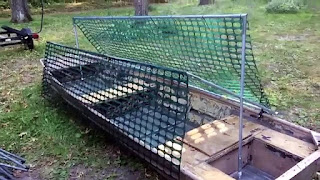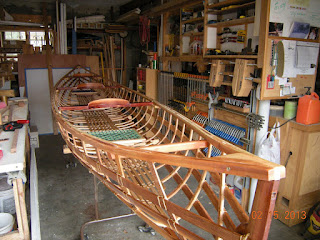Building Your First Duck Boat: A Beginner's Guide to DIY Plans
So, you're itching to build your own duck boat? That's awesome! Building a boat might sound intimidating, but with the right plans and a little patience, it's totally doable, even for a beginner. This guide focuses on creating a simple, sturdy duck boat perfect for getting you out on the water. We'll walk through the process step-by-step, making sure you feel confident every inch of the way.
Choosing Your Duck Boat Design: Simplicity is Key
For a first-time builder, simplicity is paramount. Forget those fancy, multi-compartment, tricked-out designs for now. We're going for a basic, functional duck boat that's easy to construct and maintain. There are several readily available plans online for simple designs, many of which focus on using readily available materials like plywood. Search for terms like "simple plywood duck boat plans," "jon boat plans," or "flat bottom duck boat plans". You'll find a wealth of options.
Understanding the Plans: Deciphering the Blueprint
Once you've found a set of plans you like, take your time to thoroughly understand them. Don't just skim through – really study each diagram, measurement, and instruction. Most plans will include:
- Material list: This tells you exactly what wood, fasteners, paint, and other supplies you'll need.
- Cutting diagrams: These show you how to cut your plywood sheets into the necessary shapes.
- Assembly instructions: These guide you through the process of putting all the pieces together.
- Dimensions: Pay close attention to these; accurate measurements are crucial for a properly functioning boat.
If anything is unclear, don't hesitate to look for alternative plans or seek help online. There are many helpful forums and communities dedicated to boat building.
Gathering Your Materials and Tools: Prepare for Battle (with Wood!)
This is where the real work begins. Having all your materials and tools ready before you start will save you time and frustration later on. Your material list will vary based on your chosen plans, but generally, you'll need:
- Plywood: Marine-grade plywood is essential for its water resistance. The thickness will depend on your plans.
- Fasteners: This includes screws, bolts, and possibly rivets, depending on your design. Use marine-grade fasteners for longevity.
- Wood glue: A good quality marine-grade wood glue will add strength to your joints.
- Epoxy resin (optional): This adds extra waterproofing and strength, particularly around seams.
- Paint: Choose a durable, water-resistant paint suitable for exterior use. Consider a camouflage pattern if you're hunting!
- Wood sealant: This protects the wood from rot and water damage.
Regarding tools, you'll need a circular saw or jigsaw for cutting plywood, a drill, various screwdrivers, clamps, measuring tape, sandpaper, and possibly a caulking gun if you're using sealant. Safety glasses and hearing protection are absolute must-haves.
Building Your Duck Boat: Step-by-Step Guidance
This section varies wildly based on your chosen plans, but the general process is similar across many simple designs:
Cutting the Plywood: Precision is Key
Carefully cut your plywood sheets according to your plans' cutting diagrams. Use a straight edge and a sharp blade to ensure clean, accurate cuts. Don't rush this step; accurate cuts are crucial to a well-fitting boat.
Assembling the Hull: Following the Blueprint
Most simple duck boat plans involve assembling the hull first. This usually involves joining the plywood sheets together using screws, bolts, and glue. Use clamps to hold the pieces together securely while the glue dries. Take your time and double-check your measurements at each step.
Adding the Transom: Support for the Motor
The transom is the back of the boat where the motor mounts. Ensure it's securely attached and strong enough to handle the weight of your motor. Again, follow your plans carefully.
Finishing Touches: Sealing, Painting, and Testing
Once the hull is assembled, apply wood sealant to all exposed wood surfaces. Let it dry completely before painting. Apply several coats of paint to ensure good waterproofing and durability. Once the paint is dry, carefully test your boat in a calm body of water before venturing out into more challenging conditions.
Troubleshooting and Tips
Don't be discouraged if you encounter problems. Boat building is a learning process. Here are some common issues and tips:
- Gaps in the seams: Use wood filler or epoxy to fill any gaps between plywood sheets.
- Loose screws: Use longer screws or add reinforcing pieces of wood to strengthen weak areas.
- Leaks: Carefully inspect the seams and look for any cracks or gaps. Use sealant or epoxy to repair any leaks.
Remember, patience is key. Take your time, work methodically, and don't be afraid to ask for help if you get stuck.
Frequently Asked Questions (FAQs)
Q: What type of plywood should I use?
A: Marine-grade plywood is essential. It's treated to resist rot and water damage.
Q: How long does it take to build a duck boat?
A: The time varies greatly depending on the complexity of the plan and your experience. Expect to spend several weekends, at least, on a simple design.
Q: Do I need any special tools?
A: A circular saw or jigsaw, a drill, clamps, measuring tape, and sandpaper are essential.
Q: How much does it cost to build a duck boat?
A: The cost depends on the materials you use and the size of the boat. Expect to spend several hundred dollars, at a minimum.
Q: Can I build a duck boat by myself?
A: While possible for simple designs, having a helper can be beneficial, especially for lifting and maneuvering larger pieces of plywood.
Q: Where can I find plans?
A: Search online for "simple plywood duck boat plans," "jon boat plans," or "flat bottom duck boat plans." You'll find many free and paid plans available.
Building your own duck boat is a rewarding experience. Enjoy the process, and remember to always prioritize safety!








